Pale Horse Rising
Chapter 4
Parthian History
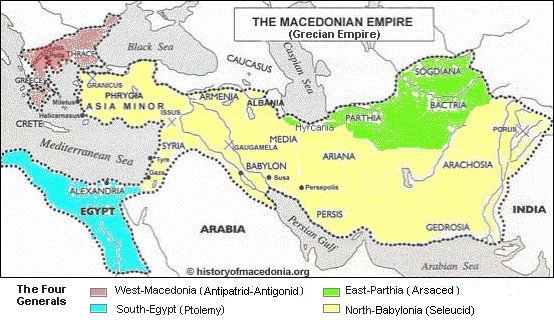
Pale Horse Rising

In Dan 8 God was only making reference to the
four of the most powerful dynastys/kingdoms that would emerge out of the
empire of Alexander
the Great and those four most powerful were
Seleucus Dynasty in Babylonia, Ptolemy Dynasty in Egypt, Antipater-Antipatrid-Antigonid
dynasties
in Macedonia, and the Arsaced Dynasty of Parthia.
These satraps (provinces of the Grecain empire) soon began warring against one another for the purpose of taking over all of Alexander's empire and uniting it once again under one ruler. Generation after generation of wars in which each gained land and lost land many times over.
Pathia was a province (satrapy) of the Grecian empire the same as, Egypt, Babylonia, etc. As such it is a candidate as one of the four horns of the Ram (Grecian empire) in Daniel's vision. In time the satrapy of Parthia expanded to the west and to the south, conquering large portions of the Seleucus Kingdom. By the fall of the last of the Seleucus Dynasty to Rome, Parthia at its height controlled most of Armenia, Mesopotamia/Babylon, Persia, and Afghanistan becoming one of the most powerful kingdoms to come out of the Grecian Empire.
Map of Parthia at the time John worte Revelation in the 1st century.

After the death of Alexander the Great his Empire was divided among his Generals and staff. Over the time of the Diadochi (successors) wars these successors amounted to a total of twenty-two rulers altogether. The satrapy (province) of Parthia, and surrounding satrapies, fell into the hands of Philip, and a Persian named Phrataphernes, who was of the staff of Alexander the Great.
The Parthians fought on the side of the Achaemenids (Media-Persia) against Alexander the Great at Arbela, and it was Darius' satrap of Parthia, Phrataphernes, who surrendered to Alexander in Hyrcania. "by whom he was kindly received, and appears to have been shortly after reinstated in his satrapy. At least he is termed by Arrian satrap of Parthia, during the advance of Alexander against Bessus, when he was detached by the king, together with Erigyius and Caranus to crush the revolt of Satibarzanes, in Aria (329 BC). He rejoined the king at Zariaspa, the following year. The next winter (328–327 BC), during the stay of Alexander at Nautaca, we find Phrataphernes again despatched to reduce the disobedient satrap of the Mardi and Tapuri, Autophradates, a service which he successfully performed, and brought the rebel a captive to the king, by whom he was subsequently put to death. He rejoined Alexander in India, shortly after the defeat of Porus; but seems to have again returned to his satrapy, from whence we find him sending his son Pharasmanes with a large train of camels and beasts of burthen, laden with provisions for the supply of the army during the toilsome march through Gedrosia. From this time we hear no more of him until after the death of Alexander (323 BC). In the first division of the provinces consequent on that event, he retained his government (in Parthia)." (1)
After the empire's unity was shattered during
the wars of the Diadochi, Parthia became part of the Seleucid Empire of
Seleucus I Nicator. Around 245 BC, the Satrap to Parthia appointed by the
Seleucids, Andragoras, allied with Diodotus I of Bactria and revolted against
the Seleucids to form his own kingdom. Arsaces I became the leader of the
Parni nomads of Parthia. In 238 BC Arsaces killed Andragoras taking the
kingdom. This began the Arsacid Dynasty. In 209 BC, Antiochus the Great
invaded the satrapy of Parthia. Soon afterwards Antiochus was defeated
by the Romans, which severely weakened the Seleucids and allowed Parthia
to maintain its freedom from the Seleucids. Arsaces II died in 191 BC and
was succeeded by Phriapatius.
In 171 BC, King Phraates I subdued the Mardi tribe, but was killed in battle against Scythians nomads. His brother Mithridates I (171-138 BCE) survived the battle and became one of Parthia's greatest Kings. In 139 BC, Mithridates I captured the Seleucid monarch Demetrius II Nicator, holding him captive for ten years while Parthian troops overwhelmed Media, Assyria, Babylonia and Persia.
King Mithridates the Great was also known as "Mithridates I of Parthia". His brother's name was Phraates and their father was Phriapatus. One can't help but notice the similarities between these names and the original satrap of Phrataphernes, the Persian general of Alexander the Great, the satrap of Parthia and wonder if they are not his descendants.. In the army of Xerxes, there was a contingent of Parthians under the command of a certain Artabazus, son of Pharnaces, probably the satrap of Parthia at the time. Among the Parthians killed in Xerxes' Greek campaign was a cavalry leader named Arsaces. All these names seem to be Persian in origin, and Arsaces is a variant of Artaxerxes, which is also Persian. Tracing Phriapatus and Phraates back to Phrataphernes as one of their ancestors is not possible through ancient texts, but soon the name of Mithdrates shows up in Parthian history of the Arsacid Dynasty.
Mithradates (meaning “gift of [the god] Mithra”)
was a common name among Anatolian rulers and we find the counter part of
this name in Anatolia with "Mithdrates I of Pontus" around 70 years earlier
as a satrap of the Grecian Empire who fought against Seleucus over Anatolia.
There seems to be a connection to both Persian and Greek ancestry in these
names and yet the Arsacid Dynasty is portrayed as being Parni of Sythian
heritage by a few historians. This Dynasty claimed to be descendents of
Artaxerxes and I tend to agree.
Israel history
63 BC – After a brief period of Israeli independence,
General Pompey conquered Jerusalem, and the
Roman conquest began.
41 BC - The Parthians conquered Jerusalem, "led by Labienus, invaded Syria, Cilicia, and Caria and attacked Phrygia in Asia Minor. A second army intervened in Judaea and captured its king Hyrcanus II. The spoils were immense, and put to good use: King Phraates IV invested them in building up Ctesiphon.” (3)
37 BC - With backing from Caesar, the Israeli
King Herod the Great placed Jerusalem under an extended siege—then successfully
invaded the city.
Rome was not able to defeat the Parthian Empire. Rome was never one of the 7 heads.
The next empire to rule over Isreal and the lands of these four great
empires was the Islamic Empire who built their capital city, Baghdad, within
eighteen to fifty miles from both Seleucia, the capital city of Seleucus,
and Babylon the capital city of King Nebbuchadnezzar. In fact each city
was probably constructed from some of the stones of the previous cities.
Satan's hot spot for sure.
Arrian in his Parthica, now lost, which was epitomized on this point
by Photius (Bibliotlteca 58) and the twelfth-century Syncellus (Corpus
scriptorum historiae Byzantinae XIII, ed. W. Dindorf, Bonn, 1829, p.539).
Photius' epitome runs as follows: "Arsaces and Tiridates were brothers,
descendants of Phriapites, the son of Arsaces [Syncellus: the brothers
"were allegedly descendants of the Persian Artaxerxes"]. Pherecles [Syncellus:
Agathocles], who had been made satrap of their country by Antiochus Theus,
offered a gross insult to one of them, whereupon... they took five men
into counsel, and with their aid slew the insolent one. They then induced
their nation to revolt from the Macedonians and set up a government of
their own."
Satraps
Phrataphernes 323 BC
Philip 321 BC - 318 BC
Peithon about 355 BC - about 314
BC
Seleucid Empire, Seleucus I Nicator
Andragoras 245 -250 BC
Kings
Arsaces I 250 - 247 BCE
Tiridates 247 - 211 BCE
Artabanus I 211 - 191 BCE
Phriapathus 191 - 176 BCE
Phraates I 176 - 171 BCE
Mithradates I 171 - 139 BCE
Phraates II 139 - 129 BCE
Interregnum 128 BCE
Artabanus II 128 - 124 BCE
Mithradates II, the Great
124 - 88 BCE
Gotarzes I (rebel king) 95 - 90 BCE
Orodes I 90 - 80 BCE
Sinatruces 80 - 70 BCE
Phraates III 70 - 57 BCE
Mithradates III 57 - 54 BCE
Orodes II 54 - 38 BCE
Pacorus I (co-ruler) 41
- 38 BCE
Phraates IV 38 - 29 BCE
Tiradates I (rebel king) 29 -
27 BCE
An interesting detail is coinage: legends were written in the Greek alphabet, and this practice was continued into the second century CE.
Phraataces 2 BCE - 4 CE
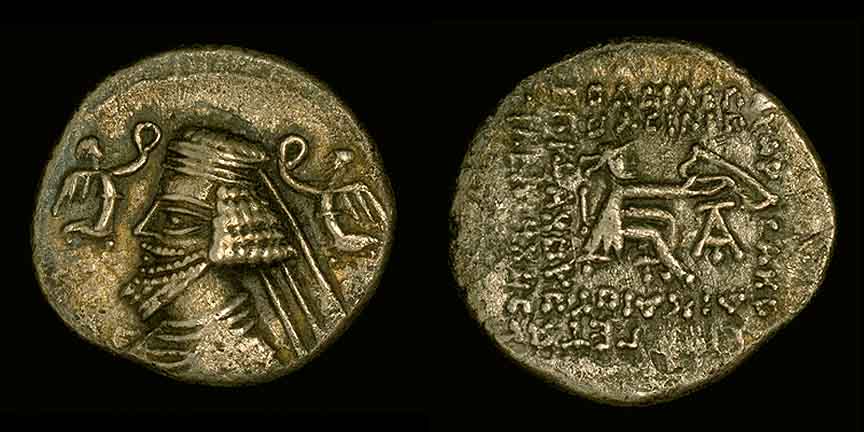
Orodes III 6 CE
Vonones I 8 - 12 CE
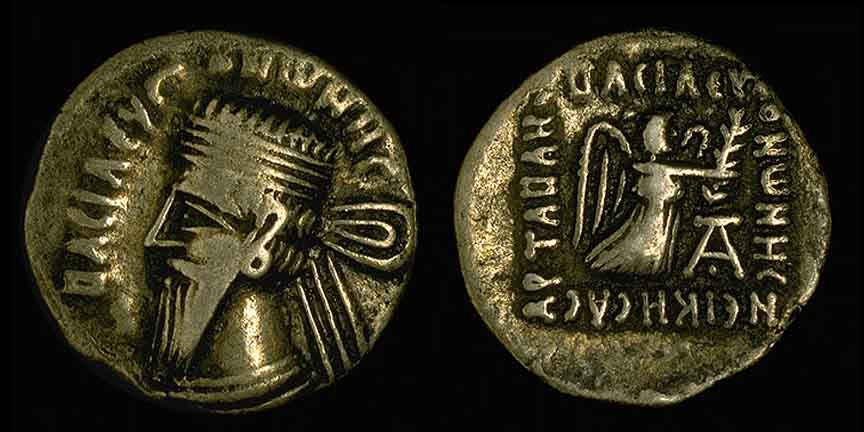
Artabanus III 10 - 38 CE
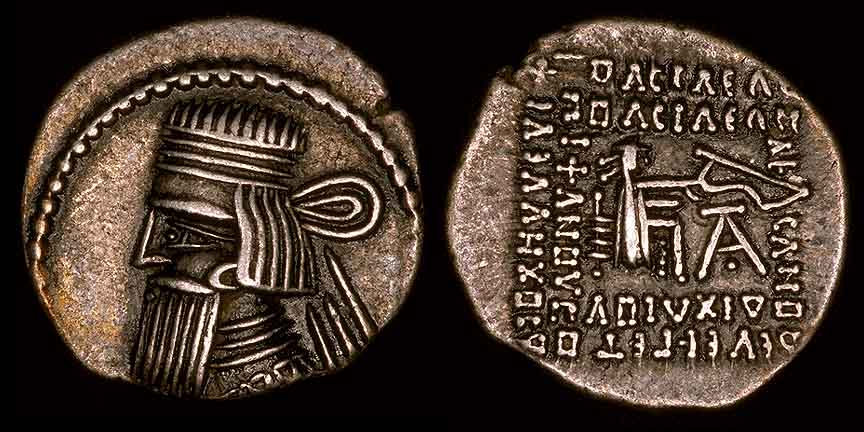
Tiridates II (rebel king)
35 - 36 CE
Vardanes I 40 - 47 CE
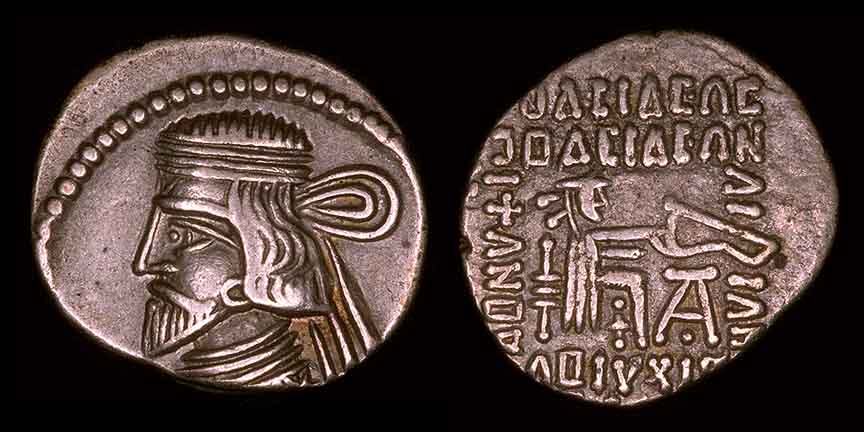
Gotarzes II 40 - 51 CE
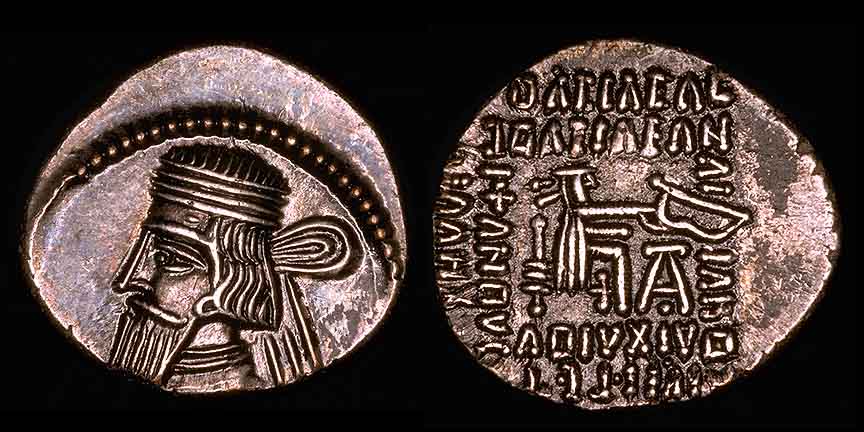
Sanabares (rebel king) 50 - 56 CE
Vonones II 51 CE
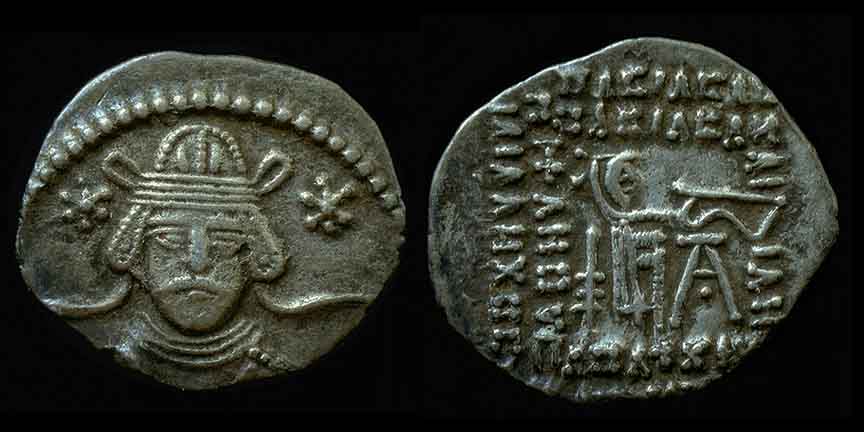
Vologases I 51 - 78 CE
This last satrap of the Grecian Empire was still in power when John wrote the Book of Revealation. It had not been conquered by Rome and remained in power and is the "one that is" as the 6th head on the beast in Rev 17.
Vardanes II (rebel king) 55 -
58 CE
Vologases II 78 - 80 CE
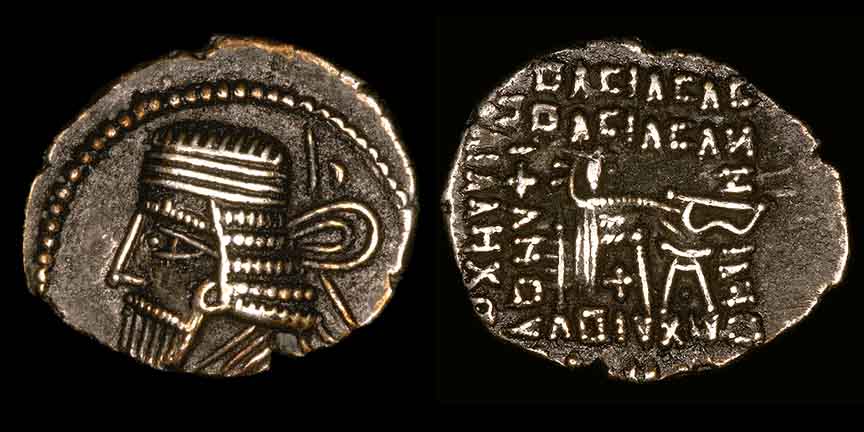
Pacorus II 80 - 105 CE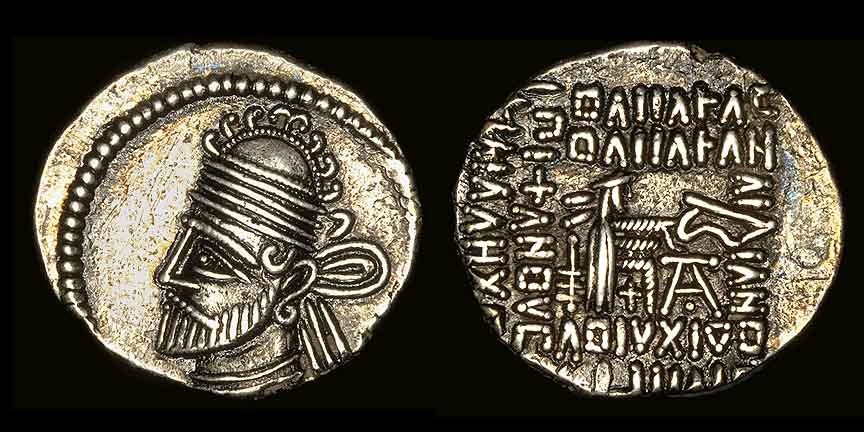
Artabanus III (rebel king) 80
- 90 CE
Vologases III 105 - 147 CE
Osroes I (co-ruler)
109 - 129 CE
Mithradates IV 140
CE
Vologases IV 147 - 191 CE
Osroes II (rebel king) 190 CE
Vologases V 191 - 208 CE
Vologases VI 208 -
218 CE
Artabanus V 216 - 224 CE
Fall of Parthia
"In A.D. 224, Ardashir, Parthian governor in
the Achaemenid home province of Persis (Fars), overthrew Artabanus IV and
established the Sasanid dynasty.
The last Parthian king, Vologases VI, issued
his last dated coin in A.D. 228. The Sasanians would ruled Persia (Iran)
until the Islamic conquest in A.D. 641." (2)
------------------------------------------------------------------------------------------------------------
(1) http://en.wikipedia.org/wiki/Phrataphernes
(2) http://www.parthia.com/parthia_history.htm
(3) http://en.wikipedia.org/wiki/Parthia
http://en.wikipedia.org/wiki/Parthian_Empire.
http://en.wikipedia.org/wiki/Diadochi
http://en.wikipedia.org/wiki/Phriapatius_of_Parthia
http://en.wikipedia.org/wiki/Mithridates_I_of_Parthia
http://encyclopedia.jrank.org/PAI_PAS/PARTHIA.html